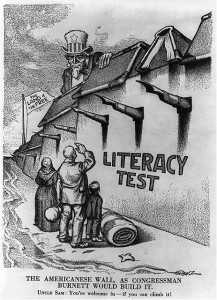Who gets accepted as a citizen or as an immigrant? Who is considered a desirable immigrant? This lesson plan examines the arrival of newcomers and the history of the entry process. Students use primary source images and texts to investigate the answer to this question for Ellis Island in the 1900s and then present evidence with supported claims. The lesson is made vivid by the task of deciding whether a particular individual described in a biographical sketch would likely be admitted or denied entry, according to the 29 questions asked by immigration officials at the time. The lesson is designed as a part of a unit on the Geography, History, and Peoples of North America, which is a focus of the Massachusetts Curriculum Frameworks in 4th grade. Examination of immigration provides a means to engage students in the study of the social geography of the United States. The proposed 2018 Massachusetts Content Standards features this example question for 4th grade: “What contributions have the various groups that have settled in North America made to the culture of each region?” Activities in the lesson “In or Out” also directly address several of the Standards for History and Social Science Practice:
2. Develop focused questions or problem statements and conduct inquiries. 3. Organize information and data from multiple primary and secondary sources. 4. Analyze the purpose and point of view of each source; distinguish opinion from fact. 5. Evaluate the credibility, accuracy, and relevance of each source. 6. Argue or explain conclusions, using valid reasoning and evidence.
 Chalk symbols written on clothing of potential immigrants during the medical exam at Ellis Island. Most of these “diagnoses” were completed in 6 seconds.[/caption] While this lesson was developed for the 4th grade, its primary source set and lesson activities could be used for a wide range of grade levels. Students work in small groups to examine the primary source text and image set about immigrants at the turn of the 20th century. They use the sources to develop a deeper understanding of the hurdles and discrimination many immigrant groups faced. In addition to learning about race-based entry policies, students will consider the ways that U.S. law flagged many types of disabilities as undesirable and would keep out an immigrant. Download PDF, or link to lesson plans and primary source sets.
Chalk symbols written on clothing of potential immigrants during the medical exam at Ellis Island. Most of these “diagnoses” were completed in 6 seconds.[/caption] While this lesson was developed for the 4th grade, its primary source set and lesson activities could be used for a wide range of grade levels. Students work in small groups to examine the primary source text and image set about immigrants at the turn of the 20th century. They use the sources to develop a deeper understanding of the hurdles and discrimination many immigrant groups faced. In addition to learning about race-based entry policies, students will consider the ways that U.S. law flagged many types of disabilities as undesirable and would keep out an immigrant. Download PDF, or link to lesson plans and primary source sets.




